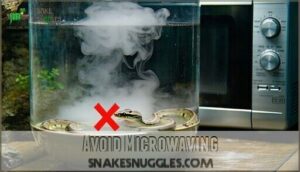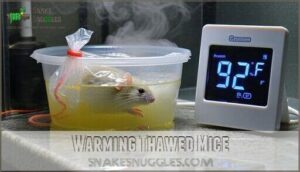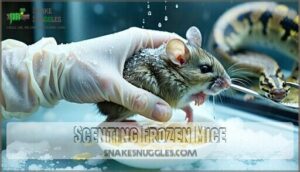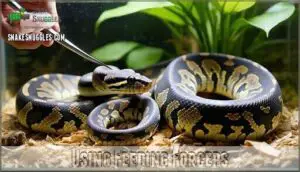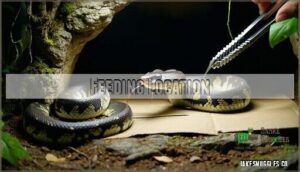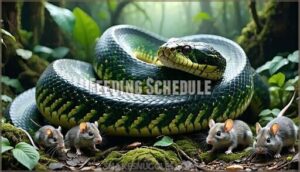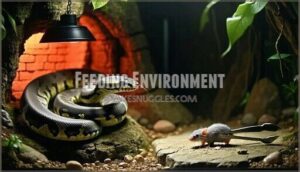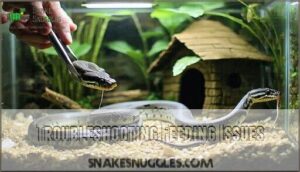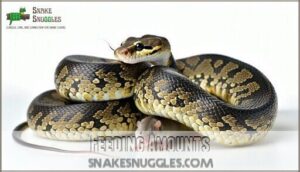This site is supported by our readers. We may earn a commission, at no cost to you, if you purchase through links.
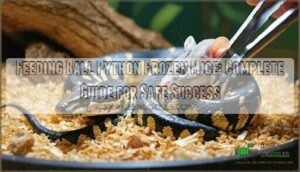
You’ll eliminate bite risks while saving money on bulk purchases.
First, thaw the mouse completely in cool water for 30-60 minutes.
Then warm it in a sealed bag using warm water until it reaches body temperature.
Use feeding tongs to present the mouse, wiggling it slightly to trigger your snake’s hunting response.
Feed in a quiet, secure environment every 1-2 weeks for adults.
Some pythons need time to adjust from live prey, but patience pays off.
The right thawing technique makes all the difference in successful feeding.
Table Of Contents
- Key Takeaways
- Advantages of Feeding Frozen Mice
- Thawing Frozen Mice
- Warming Thawed Mice
- Scenting Frozen Mice
- Using Feeding Forceps
- Feeding Location
- Feeding Schedule
- Feeding Environment
- Troubleshooting Feeding Issues
- Feeding Amounts
- Frequently Asked Questions (FAQs)
- Can ball pythons eat frozen mice?
- How to feed pet snake frozen mice?
- Why won’t my snake eat frozen mice anymore?
- How long can I leave a thawed mouse in my snakes cage?
- How long to thaw frozen mice for snake?
- How long should I leave a thawed rat with ball python?
- How do you heat a frozen mouse for a ball python?
- What size frozen mouse should I feed my snake?
- How long can thawed mice be stored?
- Can I refreeze a thawed mouse?
- Conclusion
Key Takeaways
- Thaw frozen mice completely in cool water, then warm them to 90-95°F using a sealed bag in warm water before feeding.
- Use feeding tongs to safely present the mouse and mimic live movement to trigger your snake’s hunting response.
- Feeding frozen mice reduces risks like bites, parasites, and injuries while saving money and offering storage convenience.
- Create a quiet, stress-free feeding environment with dim lighting and proper temperature to encourage natural feeding behavior.
Advantages of Feeding Frozen Mice
Your ball python’s feeding routine becomes remarkably simpler when you switch to frozen mice.
Transform feeding time from stressful guesswork into effortless routine with frozen prey.
You’ll discover Cost Savings immediately – frozen rodents cost substantially less than live prey and eliminate emergency pet store trips.
Storage Convenience means stocking up during sales and keeping months’ worth of meals in your freezer.
Parasite Reduction offers peace of mind since frozen mice carry virtually no risk of transmitting mites, worms, or other parasites that live prey often harbor.
The Increased Safety factor can’t be overstated – no more worrying about live mice biting or scratching your snake during feeding time.
Ethical Considerations matter too.
Many snake owners feel more comfortable with this humane approach to ball python feeding.
You’re also getting consistent nutrition since commercial frozen mice maintain standardized quality.
This snake feeding method transforms what used to be stressful into straightforward convenience – just thaw, warm, and serve.
Thawing Frozen Mice
Proper thawing transforms your frozen mouse from a rock-hard ice cube into a meal your ball python will actually want to eat.
You’ll need to choose between slow thawing in the refrigerator or quick thawing in warm water, but never use a microwave since it cooks the prey unevenly and can harm your snake.
Slow Thaw Method
Your fridge becomes the safest ally for frozen mice thawing. Overnight thawing prevents bacteria risk while ensuring proper preparation.
This gradual thawing method requires time investment but delivers consistent results.
- Place frozen mice in sealed containers 12-24 hours before feeding
- Position containers away from human food to avoid contamination
- Check mice are completely soft before warming for feeding to ensure proper preparation.
Quick Thaw Method
Sometimes you’re pressed for time, and the slow thaw won’t cut it. Bagged thawing in warm water speeds things up substantially.
Place your frozen mice in a sealed bag, then submerge in warm water for 30-60 minutes. Gentle agitation guarantees even thawing throughout the thawing process.
Here’s what makes this thawing method shine:
- Cuts thawing duration dramatically
- Preserves prey texture perfectly
- Prevents contamination through sealed bags
- Allows quick temperature checks mid-process
Avoid Microwaving
Microwaves turn frozen mice into a feeding nightmare for your ball python.
This appliance creates dangerous hot spots while leaving other areas frozen solid, making mealtime risky.
Why microwaving spells trouble:
- Uneven Heating – Creates scalding spots that can burn your snake’s mouth
- Nutrient Loss – High heat destroys essential vitamins your python needs
- Burning Hazard – Overheated areas pose serious injury risks during feeding
- Texture Changes – Alters prey consistency, making swallowing difficult
Warming Thawed Mice
After you’ve completely thawed your frozen mouse, warming becomes your next priority. Think of it like reheating leftovers – you want them warm, not scorching hot. Your ball python’s feeding response depends on detecting proper prey temperature, so getting this step right matters.
Target Temperatures should reach 90-95°F (32-35°C) to mimic live prey effectively. Here are proven Warming Methods:
- Warm water: Submerge the bagged mouse in warm (not hot) water for 10-15 minutes
- Heat lamp: Position the mouse under a reptile heat lamp briefly
- Heating pad: Place on low-temperature setting for gentle, Even Warming
- Hair dryer: Use cool setting while moving constantly to prevent hot spots
Temperature Monitoring prevents Overheating Risks that could burn your snake’s mouth or cook the prey temperature unevenly. Many owners find a reptile heat source is ideal for consistent results. Never microwave frozen mice – it creates dangerous hot spots. The thawing methods you choose affect final texture, so consistent warming guarantees your python recognizes dinner when you present it.
Scenting Frozen Mice
When your ball python gives frozen mice the cold shoulder, scenting becomes your secret weapon for successful feeding.
Transform stubborn eaters into eager feeders with the right scenting technique for your ball python.
This technique transforms bland prey into an irresistible feast by enhancing natural scents that trigger your snake’s hunting instincts. Many ball python owners discover that scenting frequency matters—start with every feeding until your snake consistently accepts prey.
Scenting Methods that work wonders include:
- Broth Alternatives: Dip mice in sodium-free chicken broth or diluted tuna juice for appetizing aromas
- Natural Scents: Rub prey with used substrate from rodent cages to mimic wild environments
- Blood Enhancement: Apply a few drops of fresh blood to the mouse’s nose area
- Cross-Species Appeal: Try scenting with chick or quail for Prey Preference variety
Different snakes respond to different scent profiles, so experiment patiently. Some owners find success rolling thawed mice in shed snake skin or dabbing small amounts of fish oil. Consider using specialized scenting products to enhance the appeal. Remember, less is more—subtle scenting often proves more effective than overwhelming aromas in your ball python feeding guide.
Using Feeding Forceps
Feeding tongs are your best friend when offering frozen mice to your ball python.
These essential tools create a safe barrier between your hands and your snake’s powerful strike, preventing accidental bites while reducing stress for both of you.
Proper feeding techniques start with the right equipment. Many keepers find specialized python feeding tools invaluable.
- Grip the mouse firmly near its shoulders using long feeding tongs
- Wiggle the prey to mimic live movement and stimulate your python’s natural strike response
- Keep your hands well away from the strike zone for maximum bite prevention safety
Feeding Location
Now that you’ve mastered using feeding forceps, let’s talk about where to feed your ball python. The cage feeding versus separate enclosure debate has valid points on both sides. Many keepers prefer feeding inside the snake enclosure to minimize stress reduction and avoid unnecessary handling.
However, if you have multiple snakes or hygiene concerns, a separate feeding container works well. Your feeding environment should prioritize your python’s comfort in a quiet place with privacy.
To create an optimal feeding environment, consider the following steps:
- Place substrate protection like cardboard under the prey
- Dim lighting to simulate natural hunting conditions
- Position a hide nearby for security
- Remove any obstacles that might interfere with striking
Feeding Schedule
The right ball python feeding schedule keeps your snake healthy and stress-free.
Consistent timing helps your python anticipate meals, reducing anxiety and encouraging better appetite.
Your snake’s age determines how often you’ll offer frozen mice, with younger pythons needing more frequent meals than adults.
Proper prey size guidelines are essential to prevent digestive issues.
Follow these feeding frequency guidelines:
- Hatchlings (0-4 months): Every 5-7 days with small prey
- Juveniles (4-12 months): Every 7-10 days with appropriate prey size
- Sub-adults (1-2 years): Every 10-14 days with larger meals
- Adults (2+ years): Every 14-21 days with full-sized prey
- Large adults: Every 21-30 days with seasonal adjustments
Weekly frequency works well for most juveniles, while adult schedules allow longer intervals between meals.
Feeding Environment
Setting up the right atmosphere can make or break your ball python feeding success. Your snake’s cage setup should feel like a cozy restaurant rather than a bustling cafeteria. Stress reduction starts with creating hiding spots where your python feels secure during meals. Think of it as giving them their own private dining room.
Lighting conditions play a huge role in encouraging natural ball python feeding behavior. Dim the lights or use red bulbs to mimic twilight hours when these nocturnal hunters are most active. A proper temperature gradient helps digestion, so maintain warmth without overheating the frozen mice. Ball pythons primarily feed on rodents, so prey selection is important.
When using feeding tongs, move slowly and deliberately to avoid startling your snake. Remember, a stressed python won’t eat, so patience is your best friend.
- Provide secure hiding spots for privacy
- Dim lighting to encourage natural behavior
- Maintain proper temperature gradient throughout enclosure
- Use slow, deliberate movements with feeding equipment
- Keep the environment quiet and distraction-free
Troubleshooting Feeding Issues
Even perfect feeding setups can’t prevent every hiccup. Ball python feeding challenges happen to the best of us, but understanding common refusal reasons helps you tackle them head-on.
Three Primary Causes of Prey Rejection:
- Temperature Issues – Your snake’s enclosure runs too hot or cold, disrupting their natural feeding response
- Stress Factors – Recent handling, cage changes, or environmental disturbances create feeding refusal
- Natural Cycles – Stuck shed periods or seasonal variations cause inconsistent appetite
Don’t let a picky eater stress you out. Ball pythons can safely skip meals for weeks without harm. Try offering different prey colors, adjusting feeding times, or using scenting techniques to spark interest.
Watch for regurgitation problems, which signal underlying health issues requiring veterinary attention. Remember, patience beats panic when dealing with feeding challenges – your snake’s natural instincts will usually kick in eventually.
Feeding Amounts
After addressing feeding problems, getting the feeding amounts right becomes your next priority. Think of it like Goldilocks – not too much, not too little, but just right for your python’s needs.
Prey size should equal 10-15% of your snake’s body weight. Frozen mice feeding success depends on matching portions to your python’s growth stages.
Here’s your feeding roadmap:
- Juveniles (under 1 year): Feed every 5-7 days with appropriately sized frozen mice size options
- Sub-adults (1-3 years): Move to weekly feeding with larger prey sizes
- Adults (3+ years): Feed every 10-14 days with ball python diet portions matching their slower metabolism
Weight monitoring prevents obesity prevention issues. Feeding frequency adjustments keep your snake healthy – younger pythons need more frequent meals, while adults can wait longer between feedings.
Remember, a slightly hungry python is healthier than an overfed one.
Frequently Asked Questions (FAQs)
Can ball pythons eat frozen mice?
Yes, ball pythons can safely eat frozen mice when properly thawed and warmed.
You’ll need to thaw them completely, then warm to 90-95°F before feeding with tongs to encourage your snake’s natural feeding response.
How to feed pet snake frozen mice?
Feeding your snake properly isn’t rocket science!
Thaw frozen mice in warm water, heat to 90-95°F, then use tongs to wiggle them like live prey.
Your python will strike and constrict naturally.
Why won’t my snake eat frozen mice anymore?
Your snake might’ve gotten picky or stressed.
Try scenting frozen mice with chicken broth, warming them properly to 90-95°F, or switching prey colors.
Check your feeding environment and consider skipping a meal before trying again.
How long can I leave a thawed mouse in my snakes cage?
Wondering how long’s too long?
You shouldn’t leave a thawed mouse in your snake’s cage for more than 24 hours.
After that, bacteria grows rapidly, making it unsafe and potentially causing serious health issues.
How long to thaw frozen mice for snake?
Thaw frozen mice in warm water for 30-60 minutes until completely soft.
You’ll know they’re ready when there’s no frozen core.
Then warm them to 90-95°F before feeding your snake.
How long should I leave a thawed rat with ball python?
Like a ticking clock at dinner time, you shouldn’t leave that thawed rat sitting around too long.
Remove it after 24 hours if your ball python hasn’t eaten to prevent spoilage and bacterial growth.
How do you heat a frozen mouse for a ball python?
Warm a frozen mouse by sealing it in a plastic bag, then submerging it in warm water (not boiling) for 10-20 minutes.
Aim for 90-95°F, and use tongs to handle it safely.
What size frozen mouse should I feed my snake?
Choose a frozen mouse no wider than your snake’s thickest body part.
For hatchlings, pinkies or fuzzies work best.
Adult ball pythons can handle small adult mice or rats, depending on their size.
How long can thawed mice be stored?
You can’t stretch thawed mice storage time—use them within 24 hours.
After that, bacteria can party like it’s 1999, making them unsafe.
Always discard leftovers to keep your snake healthy and happy.
Can I refreeze a thawed mouse?
You shouldn’t refreeze a thawed mouse.
Once thawed, bacteria can grow, making it unsafe for your snake. If unused, discard it.
Always thaw only what you need to avoid waste and health risks.
Conclusion
Mastering the art of feeding ball python frozen mice takes a little practice, but it’s worth the effort.
You’ll keep your snake safe from potential injuries, save time, and enjoy the convenience of frozen prey.
With proper thawing, warming, and presentation techniques, your python will soon thrive on this feeding method.
Remember, patience is key if your snake needs time to adjust. Stick with it, and you’ll create a stress-free routine for both you and your pet.
- https://ballpythoncare.net/ball-python-feeding/
- https://www.reptileadvisor.com/ball-python-feeding/
- https://scalecompanions.com/what-do-ball-pythons-eat/
- https://snakesinfo.com/feeding-a-ball-python/
- https://fycjournal.ucdavis.edu/sites/g/files/dgvnsk16091/files/inline-files/Combating-Hunger-Strikes-in-Captive-Snakes.pdf




